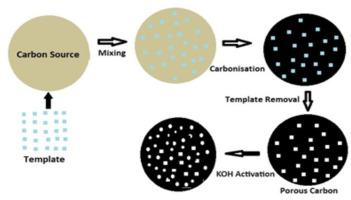当前位置:
X-MOL 学术
›
Surf. Interfaces
›
论文详情
Our official English website, www.x-mol.net, welcomes your feedback! (Note: you will need to create a separate account there.)
Organo-inorganic hybrid IPN sourced porous carbons and their lead decontamination perspectives
Surfaces and Interfaces ( IF 6.2 ) Pub Date : 2024-03-13 , DOI: 10.1016/j.surfin.2024.104196 AS Rajalakshmi , V SivanandanAchari , V Sekkar
Surfaces and Interfaces ( IF 6.2 ) Pub Date : 2024-03-13 , DOI: 10.1016/j.surfin.2024.104196 AS Rajalakshmi , V SivanandanAchari , V Sekkar

|
The present communication is about generation of porous carbons through sacrificial template route, from organo-inorganic hybrid interpenetrating polymer networks (IPN's) and their use as a remediation tool for the removal of lead ions from contaminated water. The hybrid IPN's between phenol-formaldehyde (PF) polymer and silica were formed through sequential IPN formation route, in which, silica network was formed first through sol-gel process involving tetraethoxysilane (TEOS) dispersed in phenolic resin followed by thermal crosslinking of the later. The resulting PF/SiO IPNs were transformed to C/SiO composites through carbonization at 1000 °C under inert atmosphere with silica contents ranging from 10 to 70 %. The silica phase was sacrificed through hydrogen fluoride (HF) leaching to obtain porous carbons, which were further chemically activated with KOH. The derived porous carbons had hierarchical open pore geometry with majority of the pores belonging to the meso category. The carbons were employed to scavenge lead (Pb) ions from aqueous effluents and a maximum uptake of 177.3 mg of Pb ions per gram of the adsorbent, was achieved with the present carbons. The adsorption was studied with standard adsorption models, such as Langmuir and Freundlich, of which a better compliance with Langmuir model was noted. Adsorption between the PFSiC carbons and Pb ions obeyed second order kinetics.
中文翻译:

有机-无机杂化 IPN 来源的多孔碳及其铅净化前景
本次交流是关于通过牺牲模板途径从有机-无机杂化互穿聚合物网络(IPN)生成多孔碳及其作为去除污染水中铅离子的修复工具的用途。酚醛(PF)聚合物和二氧化硅之间的杂化IPN通过顺序IPN形成路线形成,其中首先通过溶胶-凝胶过程形成二氧化硅网络,涉及分散在酚醛树脂中的四乙氧基硅烷(TEOS),然后热交联后者。所得的 PF/SiO IPNs 在惰性气氛下于 1000 °C 下通过碳化转化为 C/SiO 复合材料,二氧化硅含量范围为 10% 至 70%。通过氟化氢(HF)浸出二氧化硅相以获得多孔碳,并用 KOH 进一步化学活化。衍生的多孔碳具有分层开孔几何形状,大部分孔隙属于介观类别。这些碳用于清除废水中的铅 (Pb) 离子,并且用本发明的碳实现了每克吸附剂最大吸收 177.3 毫克铅离子。使用标准吸附模型(例如 Langmuir 和 Freundlich)研究吸附,其中注意到更好地符合 Langmuir 模型。 PFSiC 碳和 Pb 离子之间的吸附遵循二级动力学。
更新日期:2024-03-13
中文翻译:

有机-无机杂化 IPN 来源的多孔碳及其铅净化前景
本次交流是关于通过牺牲模板途径从有机-无机杂化互穿聚合物网络(IPN)生成多孔碳及其作为去除污染水中铅离子的修复工具的用途。酚醛(PF)聚合物和二氧化硅之间的杂化IPN通过顺序IPN形成路线形成,其中首先通过溶胶-凝胶过程形成二氧化硅网络,涉及分散在酚醛树脂中的四乙氧基硅烷(TEOS),然后热交联后者。所得的 PF/SiO IPNs 在惰性气氛下于 1000 °C 下通过碳化转化为 C/SiO 复合材料,二氧化硅含量范围为 10% 至 70%。通过氟化氢(HF)浸出二氧化硅相以获得多孔碳,并用 KOH 进一步化学活化。衍生的多孔碳具有分层开孔几何形状,大部分孔隙属于介观类别。这些碳用于清除废水中的铅 (Pb) 离子,并且用本发明的碳实现了每克吸附剂最大吸收 177.3 毫克铅离子。使用标准吸附模型(例如 Langmuir 和 Freundlich)研究吸附,其中注意到更好地符合 Langmuir 模型。 PFSiC 碳和 Pb 离子之间的吸附遵循二级动力学。



























 京公网安备 11010802027423号
京公网安备 11010802027423号